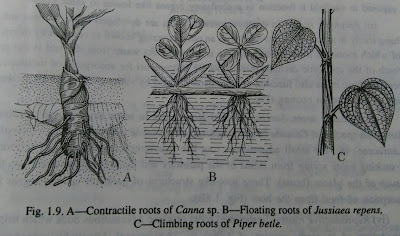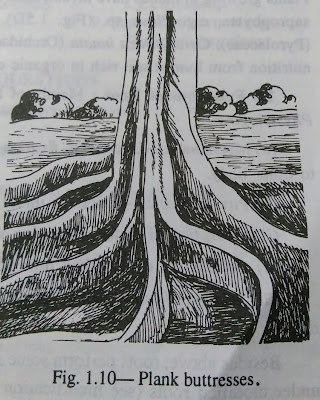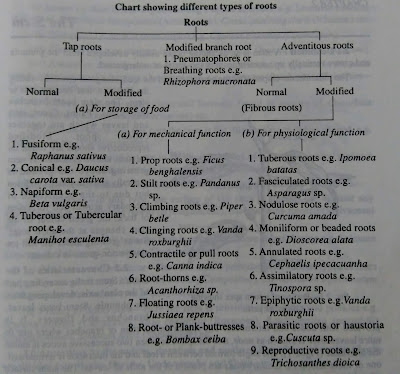Roots
Modified Roots: Both tap
roots and adventitious roots may be modified for carrying out special functions- either physiological or mechanical.
 |
| Modified tap roots |
A) MODIFIED TAP ROOTS-For physiological funtions (storage of foods) :
1. Storage Roots-These roots become fleshy and swollen due to the accumulation of food stored in roots. The modification of tap roots consists in the enormous swelling and enlargement of the primary root with slender hair like lateral or branch roots. The tap root is modified in plants having biennial habit i.e. those plants which live fer two years and within this period they are to face favourable and unfavourable seasons; in the unfavourable season the upper part dies; next year’s growth is completed at the expense of food stored in the modified root. So this type of modified tap root is meant for storage of enormous quantity of food that is to be utilised at the time of need.
Read also-
Roots: Definition,characteristics, types and regions of roots-digieduco
There are four types of such modified tap roots, viz:
(i) Fusiform-In this type the tap or primary root is swollen in the middle and tapering at both ends (upper and lower ends). e.g. Radish [Raphanus sativus (Brassicaceae)].
(ii) Conical-In conical type the tap root is broadest on top and gradually tapering towards the lower end resemblin g a cone. e.g. Carrot [Daucus carota var. sativa (Apiaceae)].
(iii) Napiform-In this type, the tap root is swollen in the upper part in the hypocotyl region and the lower part abruptly tapers forming a slender structure e.g. Turnip [Brassica rapa (Brassicaceae)], Beet [Beta vulgaris (Chenopodiaceae)] etc.
(iv) Tubemus or Tubercular root-This type of root is seen in Mirabilis jalapa (Nyctaginaceae), Ruellia tuberosa (Acanthaceae), Manihot esculenta (Tapioca, Euphorbiaceae), some species of Dahlia (Compositae) etc. Thick and neshy tap root and its branches without any definite shape are called tuberous or tubercular root.
B. MODIFIED BRANCH ROOT-For physiological function (i.e. respiration).
(i) Pneumatophores or'Breathing roots-These are the modified branches of tap root system, growing vertically up above the soil and have pores at their apices through which atmospheric air enters for respiration. The problem of respiration which is difficult in saline soil poor in oxygen is served by these negatively geotropic respiratory (Pneumatophores) roots. These roots are found in halophytes like Rhizophora s'p., Ceriops sp. of Rhizophoraceae.
 |
| Modified branch roots |
C. MODIFIED ADVENTITIOUS ROOT
(a) For physiological function (i.e. storage of food)-
(i) Tuberous roots-Jn sweet potato (lpomoea batatas, Convolvulaceae), Orchis sp. (Orchidaceae), etc. these roots arise from the nodes of the prostrate stem, become enlarged
or swollen irregularly without forming any definite shape and store food.
(ii) Fasciculated roots-In this type, roots develop in clusters from the base of the main stem-these are also swollen like tuberous roots e.g. Asparagus sp. (Liliaceae). In orchis sp. (Orchidaceae), a pair of succulent tuberous root is found.
(iii) Nodulose roots-In Curcuma amada (Mango-ginger, Zingiberaceae), Maranta sp. (Marantaceae), Costa: :peciosus (Zingiberaceae) etc. many adventitious roots which come out from the rhizome, become swollen and nodule-like at their tips and become full of food.
(i v) Moniliform or Beaded roots-In this type, roots are alternately swollen and constricted presenting at regular intervals 3 beaded appearance e.g. grasses and sedges (Cyperus sp.), Dioscorta alata (Dioscoreaceae) and sometimes in Vitis sp. (Vitaceae) etc.
 |
| Modified adventitious roots |
(v) Annulated roots-This type of roots leaks like rings -swellings are n'ng-like and placed one above the other, e.g. Ipecac [Cephaelis ipecacuanha (Rubiaeeae)].
(b) For mechanical function like support, fixation, protection etc.-
(i) Prop roots'-In many species of Ficus e.g. F .benghalensis, F. elastica' (Moraceae) etc. adventitious roots spring vertically downwards from the horizontal aerial branches and penetrate the earth-these roots become very much thick on touching the grnd and they support the heavy weights of branches like pillars.
(ii) Stilt roots-In Pandanus tectorious (Pandanaceae), stout adventitious roots come But obliquely downwards from the main stem and penetrate the ground in a slanting manner. These roots give additional support to prevent the plant from being uprooted.
 |
| A- prop roots, B- stilt roots |
(iii) Climbing roots-These roots, developing from the nodes and internodes, also aid the plants like Piper betle (Piperaceae), species of Scindapsus, Pothos (Araceae) in climbing up walls or any other support-these roots provide a foot-hold for the trail climbers on neighbouring supports.
(iv) Clinging roots are special kinds of short attaching roots. These short roots developing from the stem penetrate into cracks or crevices, in the bark of the supporting plant for additonal fixation-clinging roots also help to absorb some quantities of food from the accumulating debris of the supporting plant, e.g.--Hedera helix (Araliaceae). epiphytic orchids like Vanda roxburghii (Orchidaceae).
 |
| A- clinging roots , B- A stem parasites viscera sp. |
(v) Contractile or Pull roots-Underground stem of some plants like Allium cepa (Liliaceae), Canna indica (Cannaceae) etc. possess this type of roots. These roots by their contraction or swelling keep the aerial part of the plant erect. As a result position of the underground stem changes from horizontal to vertical.
 |
| A- contractile roots, B- floating roots, C- climbing roots |
(vi) Root-thorns-ln plants like species of Acanthorhiza, Iriartea(Arecaceae),some of the adventitious roots developing from the base of the stem become hard pointed and thorn-like. These are called root-thorns function of which is protection against animal attack.
(vii) Floating roots-In Jussiaea repens (Onagraceae) spongy, soft and cottony mots spring from the nodes in addition to normal adventitious roots ; these roots are full of innumerable air spaces and thus help the plant in maintaining buoyancy on water. ‘
(viii) Root or Plank buttresses-In large trees like Stemulia foetida (Sterculiaceae), Bombax ceiba (Bombacaceae), Terminalia catappa (Combretaceae) large plank-like roots radiating from the base of the tree provide extra support from being uprooted-these are called rootor plank buttresses. According to Francis‘. “buttresses of large trees are the combined extensions of roots and stems.”
 |
| Plank buttresses |
(c) To carry out vital functions
(i) Assimilatory roots-Invariably roots do not contain chloroplasts but in Plants like Tinospora cordifolia (Menispermaceae) and Cereus sp. (Cactaceae), adventitious roots originate from the stem, these roots contain chloroplasts. When the surfaces get exposed to sunlight it function as assimilatory organs like leaves to some extent.
(ii) Epiphytic roots-In epiphytic orchids, roots are developed from the stem and hang freely in air, they are provided with an outer covering known as velamen by means of which moisture from the atmosphere is absorbed. As water from the soil is out of reach of the epiphytic orchids, these roots are instruments for absorption of moisture ; besides, these roots also function as assimilatory organs by virtue of chloroplasts present below the velamen coating.
(iii) Parasitic roots, Sucking roots or Haustoria-In some angiospermic parasitic plants like species of Cuscuta (Convolvulaceae), Orobanche (Orobanchaceae), Cassytha (lauraceae) etc. the small adventitious root-like structures i.e.rootlets called haustoria or sucking roots spring from stems of the parasites and these roots penetrate into the tissues of the plants (hosts). These root-like structures of parasites are the organs for
absorption of food from the host.
(iv) Reproductive roots-Sometimes roots produce adventitious buds which help in Pmpagation as in many Species of Agave sp. (Agavaceae). Vegetative reproduction through root-cuttings are common in lpomoea batatas (Convolvulaceae), Trichasanthe. dioica (Cucurbitaceae) etc. These roots are therefore called reproductive roots.
(v) Mycorrhizal or Sapmphytic roots-These roots are infested with fungal mycel'u. Hahn growing in humus have mycorrhizal roots and such plants are called mycorrhlzn sapmphytes, e.g. Pinu: sp. , Betula sp. (Betulaceae), Monotropa sp. (Pyrolaceae), Corallorlu'za innata (Orchidaceae) etc. Mycorrhizal saprophym get their nutrition from humus soil rich in organic compounds with the help of fungal mycelia.
Functions of Root : Mainly of two categories, viz. (a) Mechanical and (b) Physiological.
(a) MECHANICAL-under this,fixation of plant to the soil i.e. anchorage and support to other body.
(b) PHYSIOLOGICAL-Functions under this are :
(i) Absorption of water containing various nutrients in solution from the soil.
(ii) Conduction of absorbed mineral salts and water partly in upward direction.
(iii) Storage of food-Some amount of food is stored up, mainly in the permanent region.
Chart showing different types of roots
 |
| Types of roots |








anybody please tell me the name of the book and author name from which these diagrams are taken...it will a great help for me
ReplyDelete